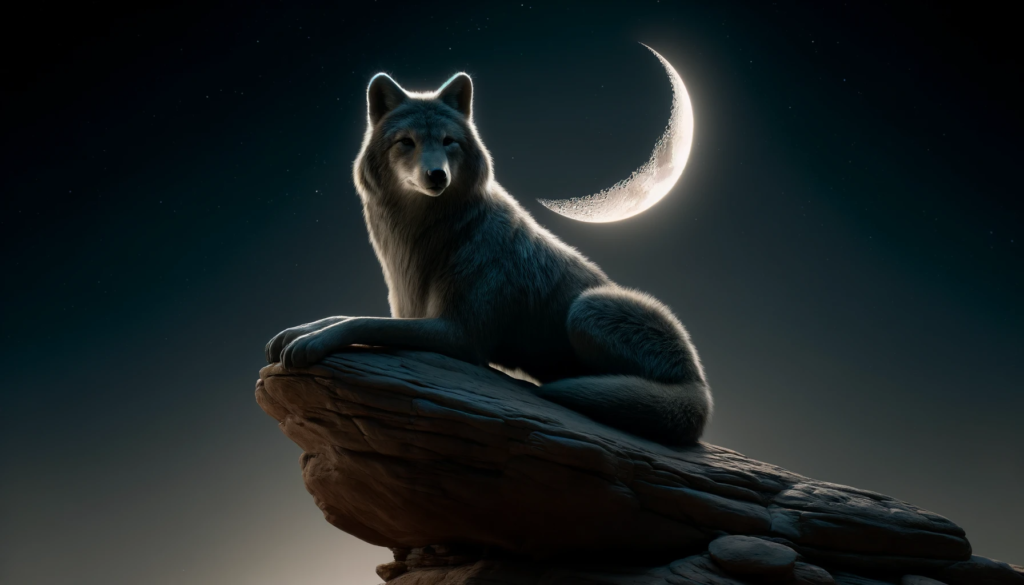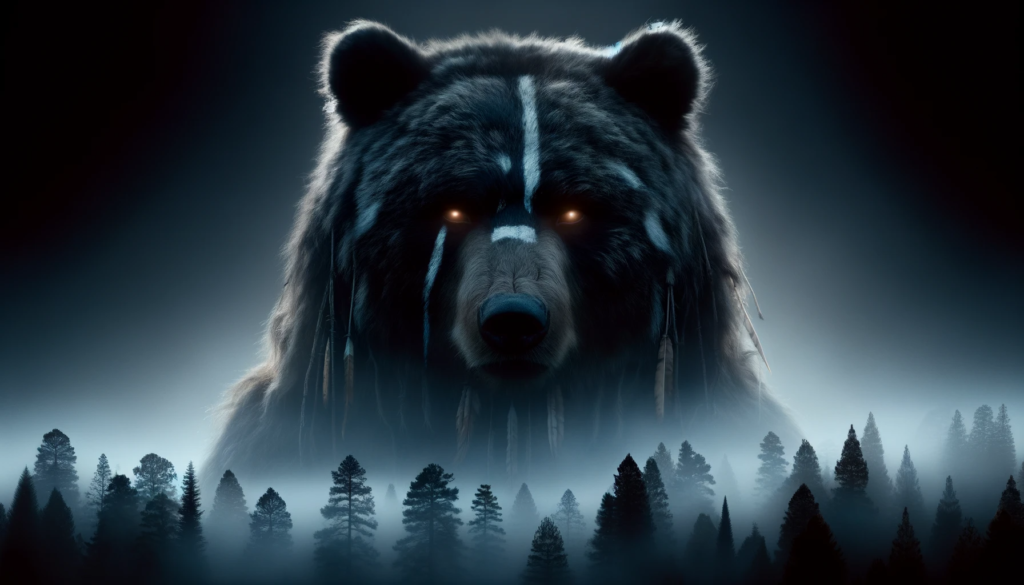Introduction
Under the vast expanse of the starlit sky in the Navajo Nation, there lurk stories woven into the very fabric of the land—tales of beings so elusive and mystifying that they’ve become part of the spiritual and cultural cornerstone of the Navajo people. These beings, known as Skinwalkers, are a topic of both reverence and reticence in Navajo culture. This blog post delves into the enigmatic world of Skinwalkers, exploring their historical roots, cultural implications, and the complex relationship between these legends and their portrayal in popular media.

Navajo Beliefs and the Origin of Skinwalker Lore
The Navajo, or Diné, as they call themselves, are one of the largest Native American tribes in the United States. Their rich history is deeply intertwined with the natural elements, believed to be imbued with the spirits of living things and ancestral powers. The concept of Skinwalkers, or “yee naaldlooshii,” which translates to “he goes on all fours” in the Navajo language, originates from this deeply spiritual context. Skinwalkers are thought to be witches or medicine men who have reached the highest level of priesthood but chose to use their powers for evil by taking the form of an animal to harm others.

The Role and Perception of Skinwalkers in Navajo Legends
In Navajo culture, the discussion of Skinwalkers is not taken lightly; it is often avoided. This reluctance stems from the fear of retribution, as Skinwalkers are said to possess the ability to read human thoughts and even take on the guise of someone familiar to commit heinous acts. Historically, Skinwalkers have been blamed for various misfortunes within communities, from sickness and drought to death.
The Importance of Storytelling in Preserving Cultural Heritage
Storytelling is a revered tradition among the Navajo, serving not only as a means of entertainment but as a crucial method of imparting moral lessons and preserving the tribe’s rich heritage and laws. The stories of Skinwalkers are often used as cautionary tales to discourage negative behaviors and to instill a sense of moral vigilance.
The Legend of the Skinwalkers
Characteristics and Supposed Powers
Skinwalkers are believed to have the supernatural ability to transform into, control, or impersonate animals. Most frequently depicted as coyotes, owls, foxes, or crows, they use these forms to travel unnoticed among people, spreading curses and misfortune. They are also said to be able to mimic human voices to lure victims into traps.

Captivating Stories and Reported Sightings
Numerous anecdotes from within the Navajo community speak of eerie encounters with creatures that they believed to be Skinwalkers. One such story recounts a night when a family, huddled by their campfire, heard the chilling sounds of a baby crying not far from their home. Recalling the teachings of their elders, they ignored the cries, suspecting it to be a Skinwalker attempting to lure them into the darkness.
Cultural Sensitivities Around Discussing Skinwalkers
Discussing Skinwalkers is taboo in many parts of the Navajo Nation. This sensitivity is out of respect for the dangerous and sacred nature of the yee naaldlooshii. For this reason, details in this post are handled with care, aiming to respect the cultural integrity and privacy of the Navajo people.

Evolving Perceptions
In contemporary Navajo society, perspectives on Skinwalkers have evolved but the core of the traditional beliefs remains. While some view the tales as metaphors for the struggle between good and evil within oneself, others believe them to be literal truths as integral to Navajo spiritual practice.
Sensationalism vs. Respectful Representation
The media’s portrayal of Skinwalkers has often leaned towards sensationalism, which distorts and exploits Navajo beliefs for entertainment value. Movies and television shows depicting Skinwalkers rarely do so with cultural sensitivity or accuracy, instead painting them as mere monsters to be feared.
Global Comparisons
Skinwalker legends bear similarities to shapeshifter myths found worldwide, from the werewolves of Europe to the kitsune of Japan. Discussing these parallels highlights the universal themes found in folklore across different cultures, illustrating a shared human fascination with the metaphysical.
Impact on Popular Culture
Skinwalkers have increasingly been featured in horror and fantasy genres, influencing popular culture’s perception of Navajo traditions. While this has brought some awareness to the Navajo culture, it has often been at the expense of accuracy and respect.
Conclusion
The tales of the Skinwalkers are not merely relics of the past; they are living narratives that continue to evolve and resonate with the Navajo people. They serve as a reminder of the cultural depth and complexity inherent in Native American folklore, demanding respect and understanding from outsiders.
Additional Resources
For those interested in exploring more about Navajo legends and Native American folklore, numerous resources are available online and in literature. It’s crucial to seek out information from reputable sources that respect the cultural origins of these stories.
Encouraging further exploration of these tales helps to preserve the rich narrative heritage of the Navajo Nation and promotes a broader appreciation for the diverse and intricate tapestry of Native American history.
Posts
- Exploring the Rich Tapestry of American History, Culture, and Trivia (15 December 2023)
- Welcome to American Facts 101: Your Ultimate Source for Exploring American History, Culture, and Trivia (15 December 2023)
- Uncovering the Hidden Gems of the USA (15 December 2023)
- Uncovering the Untold Stories of the USA (15 December 2023)
- Exploring the Rich Tapestry of American History and Culture (15 December 2023)
- Revealing America’s Saga: The Untold Chronicles of a Nation (15 December 2023)
- Charles Carroll: The Wealthiest Revolutionary and Fearless Freedom Advocate (15 December 2023)
- Revealing The Bill of Rights: Fortifying Our Precious Liberties! (22 December 2023)
- Benjamin Franklin Exposed: Maverick Creator, Shrewd Diplomat, Timeless Visionary (22 December 2023)
- Revealing Alexander Hamilton: The Visionary Maverick Who Sculpted America’s Future (28 December 2023)
- Jefferson’s America: How a Founding Father Forged a Nation’s Destiny (30 December 2023)
- Father of the Nation: How John Adams Shaped America’s Destiny (1 January 2024)
- Forgotten Trailblazers: Revealing the Covert Champions of the Revolution (3 January 2024)
- America’s Gilded Epoch: A Tale of Swift and Monumental Change (5 January 2024)
- Unveiling the Declaration: A Beacon of Liberty and Hope (6 January 2024)
- The Great Depression: Resilience in the Face of Adversity (11 January 2024)
- Revolutionizing Brilliance: The Daring Leap of America’s Industrial Breakthrough (14 January 2024)
- Navigating the Rugged Terrain of Civil Rights Victory (18 January 2024)
- A Decade of Revolutionary Transformation and Lavish Exuberance (19 January 2024)
- Space Odyssey: America’s Bold Soar into the Celestial Frontier (21 January 2024)
- The Oregon Trail: Pioneers and Perils of the Westward Expansion (26 January 2024)
- The Louisiana Purchase: A Colossal Expansion of America’s Realm (27 January 2024)
- The Profound Influence of Immigration on the USA (28 January 2024)
- The Gold Rush: Dreams and Hardships in the West (9 February 2024)
- The Forbidden Decade: America’s Fervent Quest for Virtue (28 February 2024)
- Swinging Rhythms, Daring Flappers: A New Vision of the American Dream (1 March 2024)
- The Salem Witch Trials: Dread and Justice in Early American Colonies (3 March 2024)
- The Echoes of Liberty – Unveiling Federalist No. 1 (23 March 2024)
- Edward Rutledge: A Vanguard Spirit of Liberty’s Dawn (23 March 2024)
- John Jay: Pioneering Crusader for American Justice (29 March 2024)
- Revolt & Reason: The Untold Power of ‘Cato 1 (1 April 2024)
- Hidden Virtues: George Washington’s Secret Acts of Kindness (9 April 2024)
- How Jefferson’s Love for Meteorology Shaped the White House (9 April 2024)
- Echoes of the Night: Secrets of Navajo Skinwalkers Unveiled (10 April 2024)
- Ghost Ships of the Great Lakes (10 April 2024)
- Lincoln’s Grit: Unveiling the Wrestler-President (11 April 2024)
- Unity or Peril? The Covert Threat of Foreign Interference (14 April 2024)
- Roosevelt’s Midnight Quest: Secrets at the Smithsonian (14 April 2024)
- Revolutionary Ripples: Adams’ Potomac Epiphanies (14 April 2024)
- Washington’s Ale of Liberty: A Pioneering Patriotic Brew (14 April 2024)
- Visionary Rebellion: The Architect of U.S. Freedom (20 April 2024)
- Revealing the Legacy: The Enigma of Anti-Federalist Ideals (21 June 2024)
Categories
Tags
- Bill of Rights
- American history
- governance
- John Adams
- Founding Fathers
- American Revolution
- unsung heroes
- independence
- Great Depression
- resilience
- Gilded Age
- social changes
- Declaration of Independence
- American culture
- national identity
- economic hardship
- American Industrial Revolution
- technological advancements
- key inventions
- industrial growth
- Civil Rights Movement
- racial discrimination
- equality
- 1920s
- Roaring Twenties
- economic boom
- Space Race
- United States
- Soviet Union
- Oregon Trail
- westward expansion
- Louisiana Purchase
- immigration
- diverse cultures
- Gold Rush
- American West
- mining towns
